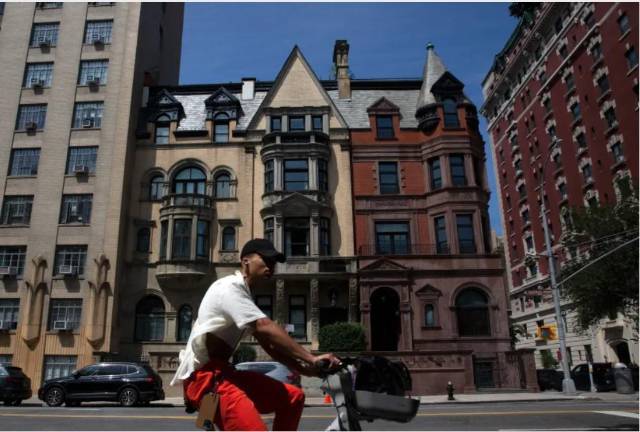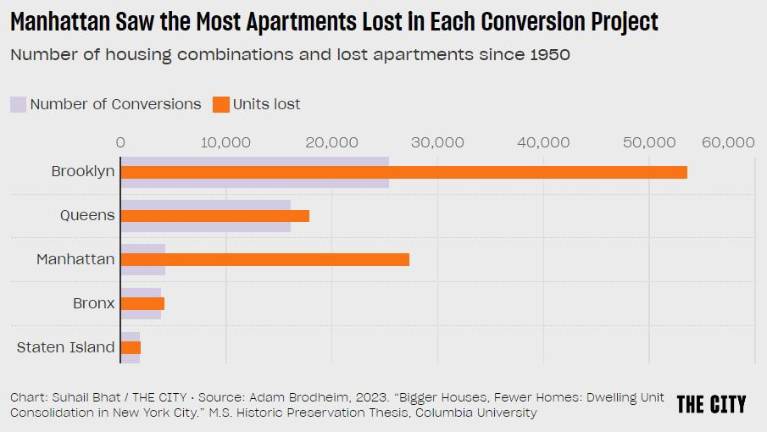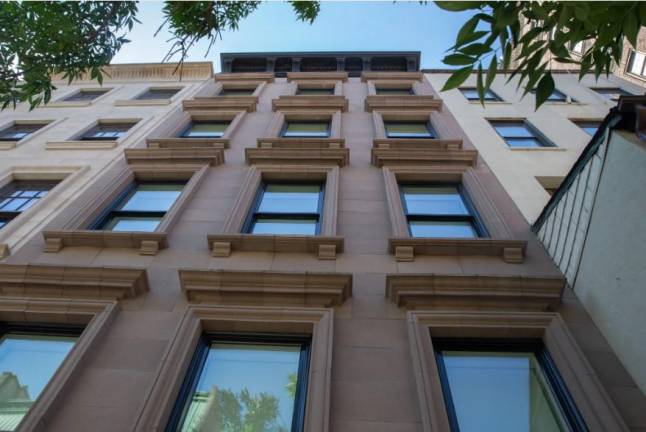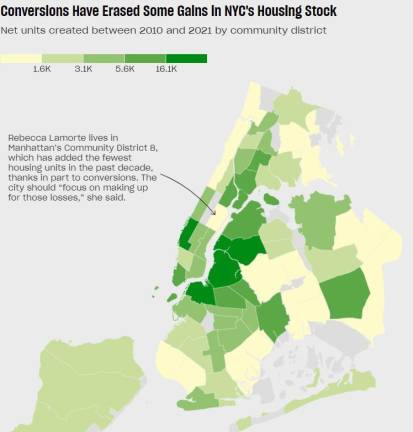NYC Lost 100K Homes in Apartment-to-House Conversions
New research of historic property records estimates the toll of mansion and other space combinations, especially in Manhattan’s wealthiest neighborhoods on the Upper East and Upper West Sides. (This article was originally published on Aug. 25 by THE CITY.)




It’s a New York dream to combine your place with the one next door to make a spacious home. But it comes at a price: over the last 70-plus years, mergers of flats and rooming houses into bigger residences have taken a steady toll on the city’s housing stock, a new study finds.
Take for example 34 E. 68th St. in Manhattan: The 1879 row house, located in the Upper East Side Historic District, once housed 17 separate apartments, according to property records. Now, it is a 9,600-square-foot single-family mansion after changing hands for $11.5 million in 2011 and a subsequent gut renovation.
Historic preservationist Adam Brodheim reviewed decades of building and planning records on historic row houses for his thesis at the Graduate School of Architecture, Planning and Preservation at Columbia University and found combinations have been most aggressive in Manhattan, where each conversion accounted for the loss of between six or seven units on average.
In Queens, such consolidations typically eliminated one apartment each, Brodheim’s research found, while in Brooklyn, each combination on average removed two apartments from existence.
[media = https://www.datawrapper.de/_/9rRrF/]
To Brodheim, the work was about making hard-to-see housing consolidation more visible. On his own block on the Upper West Side, three previously multi-unit brownstones have been converted into single-family homes over the years — but you’d never know it unless you spotted a construction permit, or noticed multiple buzzers replaced by one doorbell, he said.
“From the perspective of most people on the street, they’re not noticing that seven fewer families are able to live on this block ... and this happens all the time,” Brodheim told THE CITY. “Unlike new buildings, which have to go through this huge gauntlet of, often, public opposition to create new units, here you’re able to get rid of apartments without anyone noticing.”
Building on research on apartment combinations by the Department of City Planning in 2021, Brodheim combed through building records and compared current land use data to decades-old “I-Cards,” occupancy records the city once kept on all multi-family row houses. He also looked at alteration permits between 2010 and 2021 for a wider variety of residential buildings.
In this thesis Brodheim estimates that since 1950, New York City has lost 104,000 units of housing in row houses alone through consolidation, a regular feature of the toniest real estate listings.
In the past decade, such apartment combinations have nearly erased gains made by the construction of new housing units in the wealthiest parts of the city, particularly in the Upper East and Upper West sides of Manhattan.
[media = https://www.datawrapper.de/_/xZGjI/]
Over the last 70 years, Brooklyn lost the most row house units of any borough. There, the practice of “brownstoning” dilapidated row houses through historic restoration took off in the latter half of the last century and “was embraced by both elected officials, preservationists, and city planners as the trend grew through the 1970s and 1980s,” Brodheim wrote.
The research also shows that the loss of housing is especially acute in the city’s historic districts, where most saw a net loss of housing between 2010 and 2022. The Central Park West Historic District on the Upper West Side saw the biggest drop, with a loss of 953 units in that time, due in large part to conversions.
The trend grates on Rebecca Lamorte, a Yorkville resident who serves on the Upper East Side neighborhood’s community board as co-chair of its housing committee. Lamorte says she got a toehold in the area because she was willing to take a $1,500 ground-floor studio apartment next to Second Avenue subway construction — a noisy spot, but good for her, a person with disabilities who needs street-front access.
But that was 10 years ago, and it’s only gotten harder to find affordable housing on the Upper East Side, she says. Lamorte currently is in a different “roach-infested apartment” on the second floor of a walk-up, the only affordable place she could find in the area.
[media = https://cdn.vox-cdn.com/uploads/chorus_asset/file/24868606/082323_34_e_68th_1.jpg]
For her, the solution is not to “condemn the people who have the means to combine apartments or homes, but to focus on making up for those losses.
“We need to be putting so much more housing online,” she said. “The toothpaste is out of the tube on these apartment conversions. But the toothpaste is still stuck in the damn tube when it comes to building housing that we need.”
In her community district, just 101 units have been added on balance between 2010 and 2021, Brodheim’s research shows.
“That’s unacceptable,” she said.
Brodheim, who is a volunteer member of the pro-housing advocacy group Open New York, agrees, saying his research is not meant to demonize conversions, but to emphasize another way the housing crisis has been exacerbated.
“Trying to restrict that activity is not necessarily beneficial because there is a demand for it. What this illustrates is that you just have to build a lot more housing. You have to make up for the fact that people are doing this,” he said.
In response to the new unit-combination research, Department of City Planning Director Dan Garodnick promised future plans to take on the city’s affordability crisis.
“When housing production is limited by overly restrictive zoning and other regulations, it creates a zero-sum dynamic that leads to unit losses — especially in central, well-connected areas with good access to jobs, transit, and amenities that should be growing,” Garodnick said in a statement. “We are advancing a housing plan in the coming months that will ensure that every neighborhood contributes to housing growth and helps to address New York’s housing shortage.”
THE CITY is an independent, nonprofit news outlet dedicated to hard-hitting reporting that serves the people of New York.
“When housing production is limited by overly restrictive zoning and other regulations, it creates a zero-sum dynamic that leads to unit losses — especially in central, well-connected areas with good access to jobs, transit, and amenities that should be growing.” NYC Planning Director Dan Garodnick